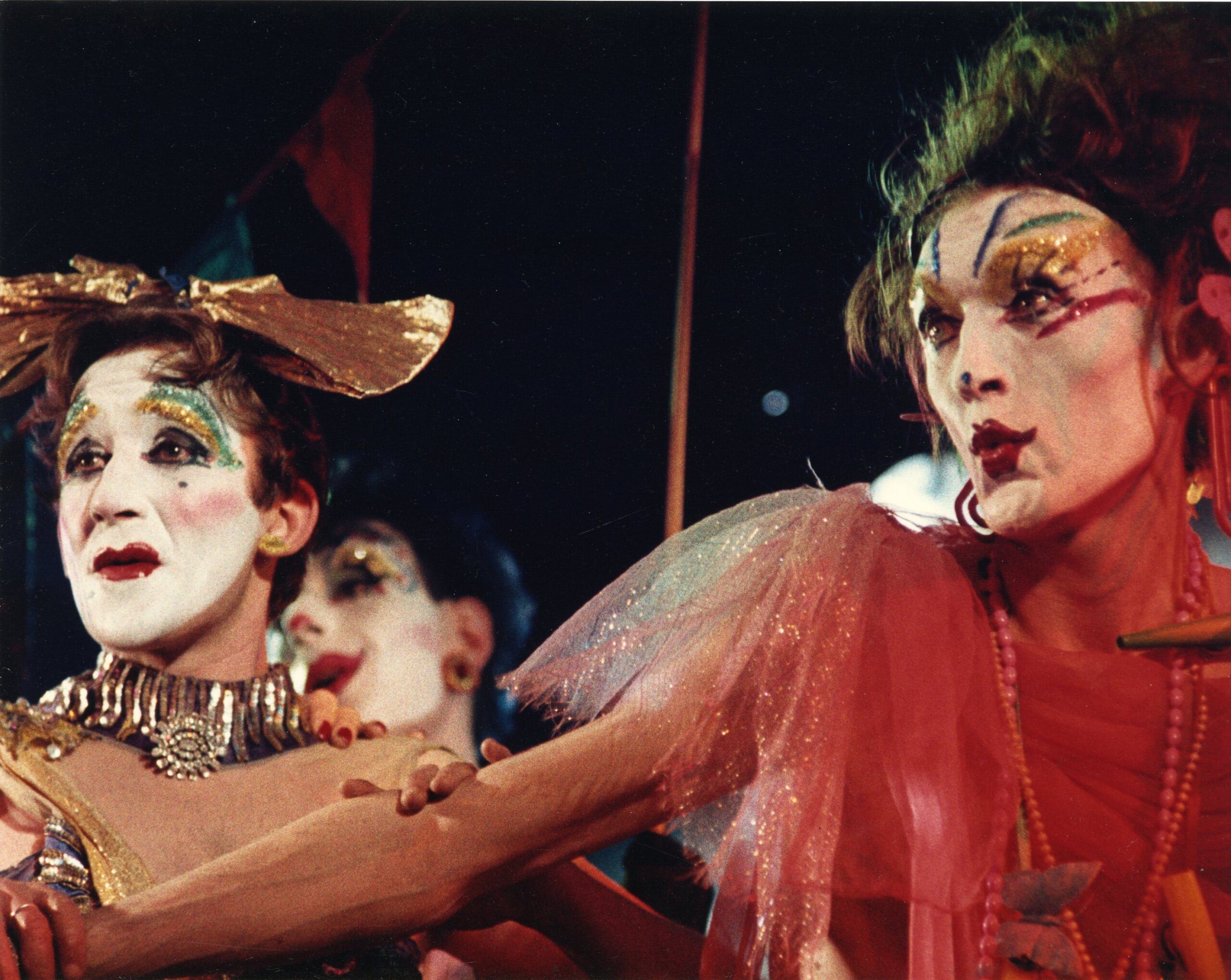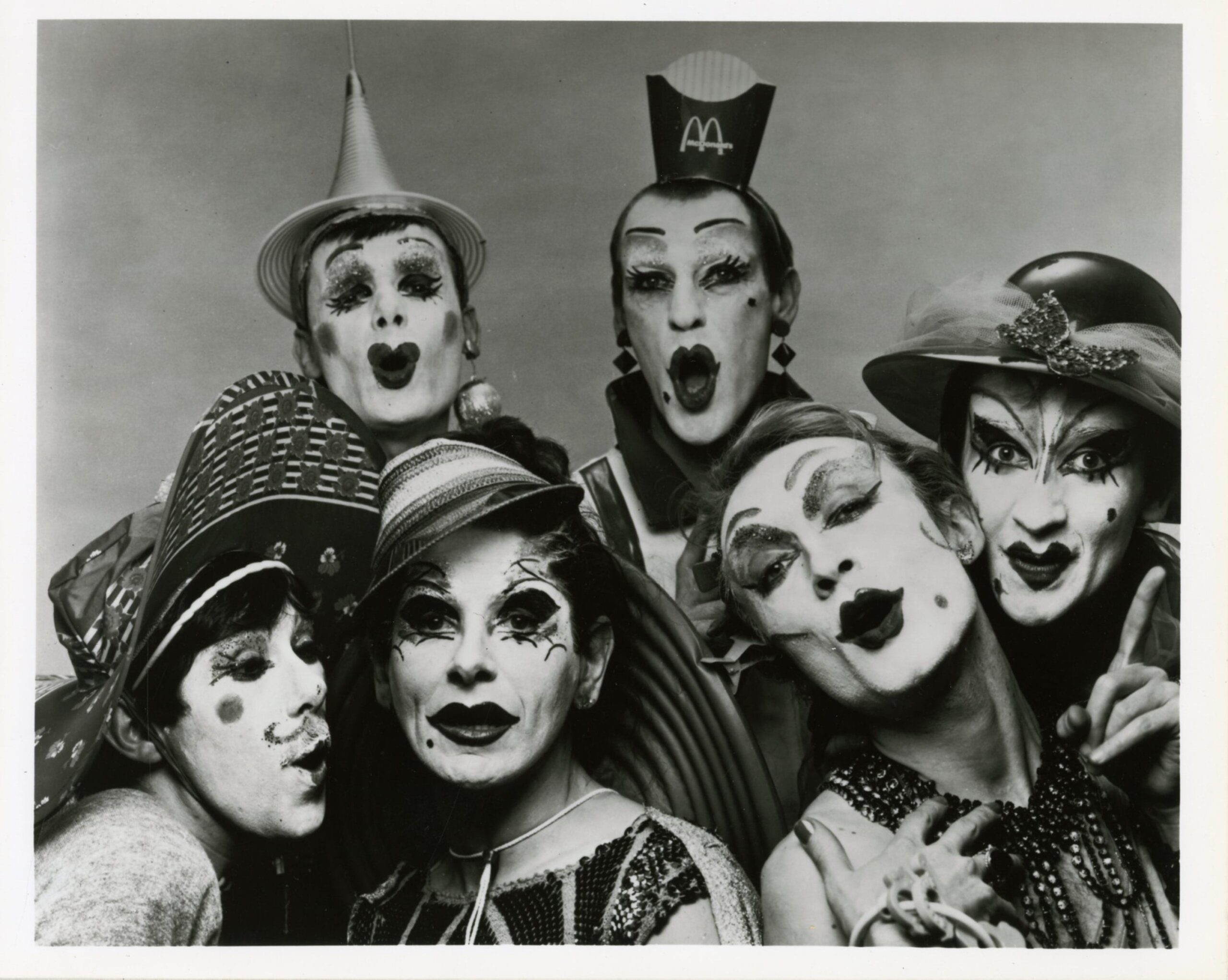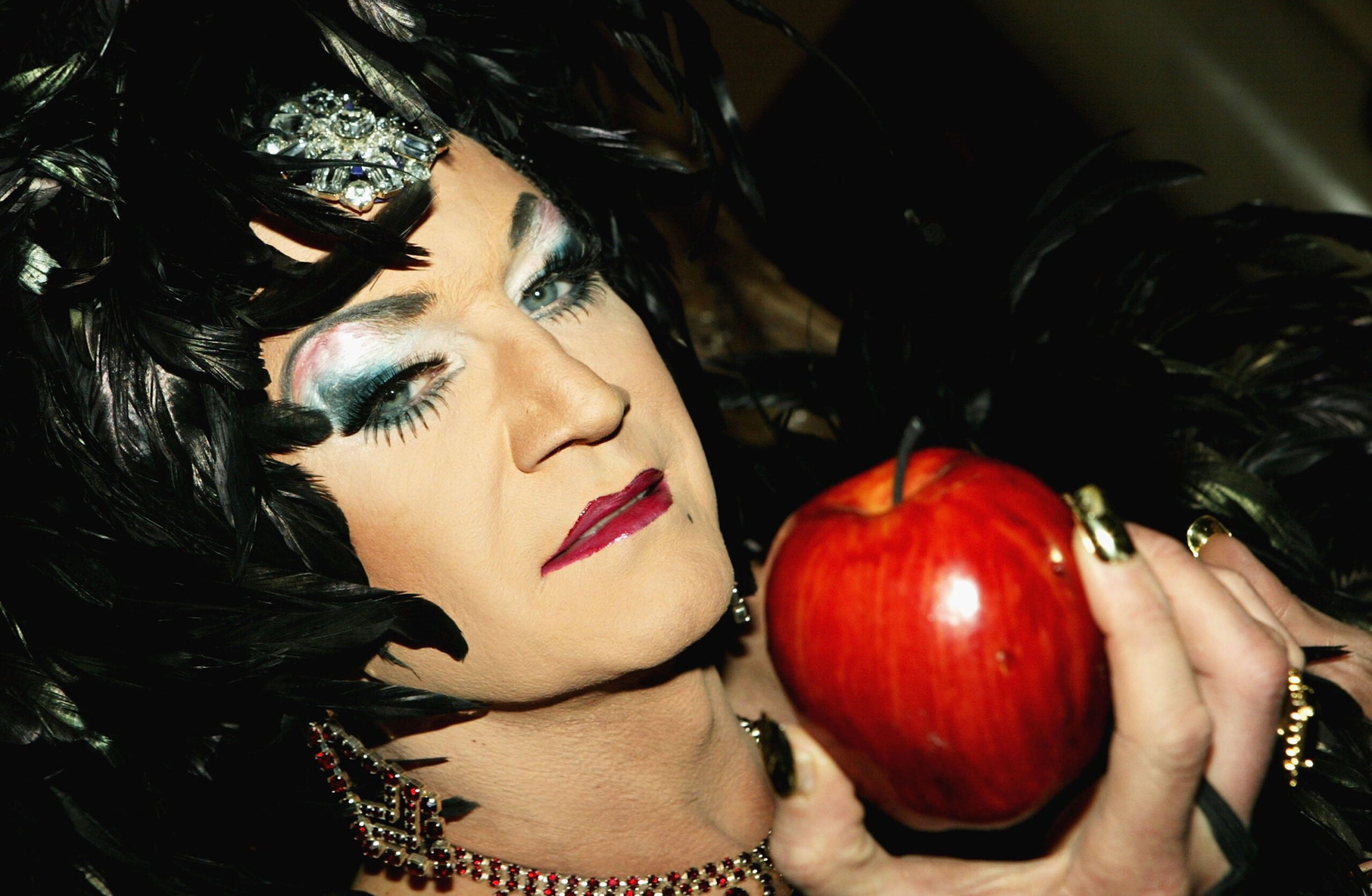Throughout the 1990s, British television was dominated by Lily Savage, an acid-tongued drag queen with sky-high blond curls, a sex-working side gig and a gloriously foul mouth. Savage was the drag alter ego of Paul O’Grady, a working-class socialist born in Liverpool, who went on to become a bona fide national treasure. Since his sudden death in late March, tributes have poured in for both O’Grady and his “blond bomb-site” character, Lily Savage, one of the most notable stars in Britain’s decades-long history of radical drag.
Before she struck gold on mainstream TV, Savage spent more than a decade perfecting her craft in gay pubs and clubs across the country, performing for audiences which gradually grew in size. Meanwhile, O’Grady was juggling jobs in care and social work, tending to the country’s poorest and most vulnerable.
Savage’s career began to blossom in the 1980s, courtesy of an eight-year residency at London’s iconic Royal Vauxhall Tavern. At the height of the AIDS crisis, the venue was raided by police officers in rubber gloves, which they supposed would protect them from contracting what was then known as the “gay plague.”
“Well, well,” quipped Savage, onstage as the police stormed in. “It looks like we’ve got help with the washing-up!” As her star ascended, she remained fiercely political. In 1997, she addressed her audience in an off-script monologue filmed for her prime-time Lily Savage Show, which the BBC “point blank refused to air,” she later explained, in an archival interview preserved on YouTube, which also features the never-broadcast rant. “We could do with a bloody good riot,” laughs Savage in the clip, joking that she had an ashtray hidden in a sock, ready to bash a policeman. “It’s not the same these days, is it? I remember when I was a girl, there was a riot every five minutes!”
This is no exaggeration. O’Grady was born in 1955, coming of age in a distinctly radical era of British history. The 1970s saw near-constant industrial action, and by the end of the decade, the British economy was beginning to tank, with working-class communities being hit the hardest. In O’Grady’s home city of Liverpool, the 1981 Toxteth riots saw Black communities riot against the racist policing of young Black men in particular, who were often stopped, searched and arrested for no reason other than looking “suspicious.” That same year, iron-clad Tory Margaret Thatcher was voted into power. During her reign as prime minister, she decimated the predominantly working-class mining industry, (which led to the formation of a solidarity group, Lesbians and Gays Support the Miners) and outlawed any mention—or, as she called it, “promotion”—of homosexuality in schools, with her infamous Section 28 legislation.
In response to this political turmoil, key activist movements were regularly being formed. In 1970, news of a growing LGBTQ+ movement had spread across the globe, spawning the creation of a British Gay Liberation Front (GLF). Their protest tactics were ballsy and attention-grabbing, often using zany costumes and drag as a medium to embarrass homophobes and spark raucous public demonstrations, known as “zaps.”
Activist Dan Glass has spent years meticulously documenting these disruptive queer histories, both in his debut book, United Queerdom (2020) and the upcoming Queer Footprints: A Guide to Uncovering London’s Fierce History. Grinning throughout our Zoom call, he reads me an excerpt from the latter, a gleefully chaotic retelling of the GLF’s hijacking of a 1971 meeting at Westminster’s Methodist Central Hall, led by the Festival of Light, a “fundamentalist Christian group” determined to “clean up Britain” by lobbying to “re-criminalize homosexuality and abortion.” In the lead-up to the meeting, a GLF member named Janet volunteered to help out the Festival of Light, effectively infiltrating their mailing list and gaining access to their plans for the day. On the morning of the meeting, GLF members turned up early in disguise and hid themselves throughout the venue. Several were dragged up as nuns; and as the crowd settled into their seats, the drag nuns solemnly filed onto the stage, before lifting up their skirts and dancing the cancan. Hundreds of mice were released into the crowd, and a GLF “minister” cried ‘Bang!’ as the room was plunged into darkness.
This chaotic, eye-catching approach is a staple of “radical drag,” Glass tells Xtra. “It’s deeply political, deeply hilarious, deeply liberatory. It’s about taking very serious issues—institutional homophobia and transphobia, medicalization, imprisonment—and using wit, satire and unapologetic, queer sassiness to confront the homophobes.”
Of course, Britain’s drag history dates back way further than the British GLF, Glass says. “There’s this incredible genealogy that dates all the way back to the molly houses of 18th century London.” In Queer Footprints, he describes the fabled molly house as “a private room or tavern for homosexual liaisons, to shed each other’s armor and see each other closer.” In these covert dens of queer intimacy, the likes of Princess Seraphina—an early example of a “recognizable drag queen”, a gender nonconformist whose existence is preserved in a 1732 court trial transcript —wiled away their evenings chatting to like-minded friends and entertaining each other.

Credit: Courtesy of the Bloolips Archive, Bishopsgate Institute
Almost three centuries later, British drag is still firmly rooted in community spirit. Dr. Phoebe Patey-Ferguson, course director of the world’s first MA in Queer Performance at Rose Bruford College, got their first taste of radical drag working at London’s iconic queer underground club and performance venue, VFD (formerly Vogue Fabrics), a playground for newcomers and veterans alike. “There was so much happening, on all of these different levels,” they say. “You would have Lavinia Co-op and Rose Wood, these performers who were in their 60s, 70s and 80s. But then you would have Lucia Blayke, who was working behind the bar, jumping last-minute into a drag competition, when she had never performed before. It was this really comfortable space where everyone was on the same page, so you could just get stuck in.”
These legacies live largely underground, but they’re gradually being documented. Lavinia Co-op was part of the radical drag troupe Bloolips, founded by Bette Bourne in 1977. Many of the performers lived together in disused buildings, which they occupied and turned into drag communes. Bloolips’s raucous performances were budget drag at its most camp and joyous: wearing wigs made from mopheads, clown-like makeup and second-hand dresses, they spread queer chaos with every outing. Patey-Ferguson developed the course as a love letter of sorts to these unsung icons, the performers whose excellence “flies under the radar,” they say. “I’ve spent my whole life watching queer performance, and I knew there was more than enough brilliance to fill a program.”

Credit: Courtesy of the Bloolips Archive, Bishopsgate Institute
Class plays a key role in British drag, too. The likes of Lily Savage and David Hoyle are known for speaking truth to power, using their acerbic wit to cut down politicians and systems failing not just queer people, but working-class people, too. Hoyle, a Blackpool-born, anti-capitalist performance artist, has been wreaking havoc for decades. In a caustic monologue, featured in a 2022 Xtra interview with Hoyle, he jokes: “I love the fact that there are 20-year-old cunts out there in the world living their stupid, self-obsessed, superficial lives when people went through real hell and had to fight for you to be as complacent as you are.” O’Grady remained similarly outspoken; in 2010, on his later daytime talk show The Paul O’Grady Show, he delivered a witty yet devastating takedown of right-wing politicians and their austerity policies, and he even helmed an in-depth exploration of Britain’s working-class history, in Paul O’Grady’s Working Britain.
The brilliance of drag is that it can be a medium for political disruption. “The police and the powers that be, they know how to deal with marches from A to B,” explains Glass. “They don’t know how to deal with nuns in drag doing the cancan. Because we live in such an insidious, tyrannical establishment—when it comes to the British Empire, the Tories—we have to be creative.” In this sense, radical drag isn’t just a genre, it’s a political tactic, especially for pissed-off, working-class activists. Glass cites Mark Ashton, co-founder of Lesbians and Gays Support the Miners, and his drag alter ego, Mary Trashton, a character rooted in a “working-class, trade union solidarity perspective.”
“Wit, satire and self-deprecation wasn’t just about cultural cachet, it was survival,” explains Glass. “Taking the piss out of the elite was personal soul food amidst a class war.”
These political wars are still ongoing. The BBC now platforms outright transphobia, but back in the 1980s and 1990s, you could find some pretty disruptive art within its programming. Patey-Ferguson particularly loves Eat the Rich, a 1987 film starring queercore icon Lanah Pellay. “She’s a trans woman of colour, but her being trans isn’t part of the story at all,” they explain. “She plays this disgruntled, working-class waitress at a fancy restaurant, but she becomes a left-wing, communist terrorist who goes on this journey to pick up other weirdos, who want to smash up the Jobcentre and start a revolution.” It’s a gloriously punk commentary on the yuppie culture of the 1980s, and one which embodies the gleeful “fuck you” of British queer art.
It’s important for today’s artists and activists to look back at these trailblazers, and to understand that activist movements worldwide have always mapped onto one another. Patey-Ferguson recalls a passage from Man Enough to Be a Woman, the autobiography of trans punk singer Jayne County. “She talks about coming to the U.K. with this incredible troupe of drag queens and trans women to perform Andy Warhol’s Pork, and seeing David Bowie in the crowd making notes, and studying their makeup and what they were wearing.” In the front row was Pete Burns, a Liverpool-born genderfuck genius who later rose to stardom as the lead singer of the chart-topping synthpop group Dead or Alive, and a comedy icon in his own right. Like Savage, Hoyle and so many queer performers, his put-downs were legendary: see his Celebrity Big Brother best bits for proof.
Luckily, these intergenerational dialogues are ongoing. ACT UP still has an active presence in the U.K., and Glass points out that both Drag Race UK star Bimini and Tom Rasmussen, whose recent album Body Building has earned rave reviews, are part of this radical drag family tree. Across the country, disruptive drag spirit is alive and well: from artists like Lady Bushra, Wet Mess and frogb0i to collectives like the Cocoa Butter Club, Drag Syndrome and A-POC-ALYPSE Cabaret, there are countless names paying tribute to this disruptive heritage in their own way, and breaking new ground.
Patey-Ferguson finds joy and solace in the knowledge that the MA in Queer Performance—a hybrid-learning course, designed to make it accessible worldwide—will facilitate new connections. “Maybe they’re watching drag performance on the internet, they’re part of trans gaming communities or they want to talk about their local scene in Latvia,” they say. “Every student will bring their own knowledge to the course, which is so much about creating space to recognize the multiplicity of queerness, not just me telling them what it means.”
Similarly, Glass has created Queer Footprints as a blueprint for other queer people around the world to map their local histories, the kind that live predominantly in basement bars, drag venues and makeshift activist headquarters. It’s a project that’s as vital as ever—since he finished the first draft of Queer Footprints back in December, “two legends within the book have died, and various queer spaces have been shut down,” he says. “Even though this was a two- or three-year project that tried to capture as much as possible, things move fast, and that’s why I wanted this book to act as a template for other people to create their queer histories.”
O’Grady’s death may be a tragic loss to Britain’s queer scene, but the caustic wit and working-class brilliance of Lily Savage is leading fans worldwide to dig deeper into this complicated country’s radical drag history. Thanks to the likes of Patey-Ferguson and Glass documenting these histories, and today’s drag performers walking in these disruptive footsteps, the influence of Britain’s most chaotic, political and decidedly punk drag artists continues to endure.


 Why you can trust Xtra
Why you can trust Xtra


